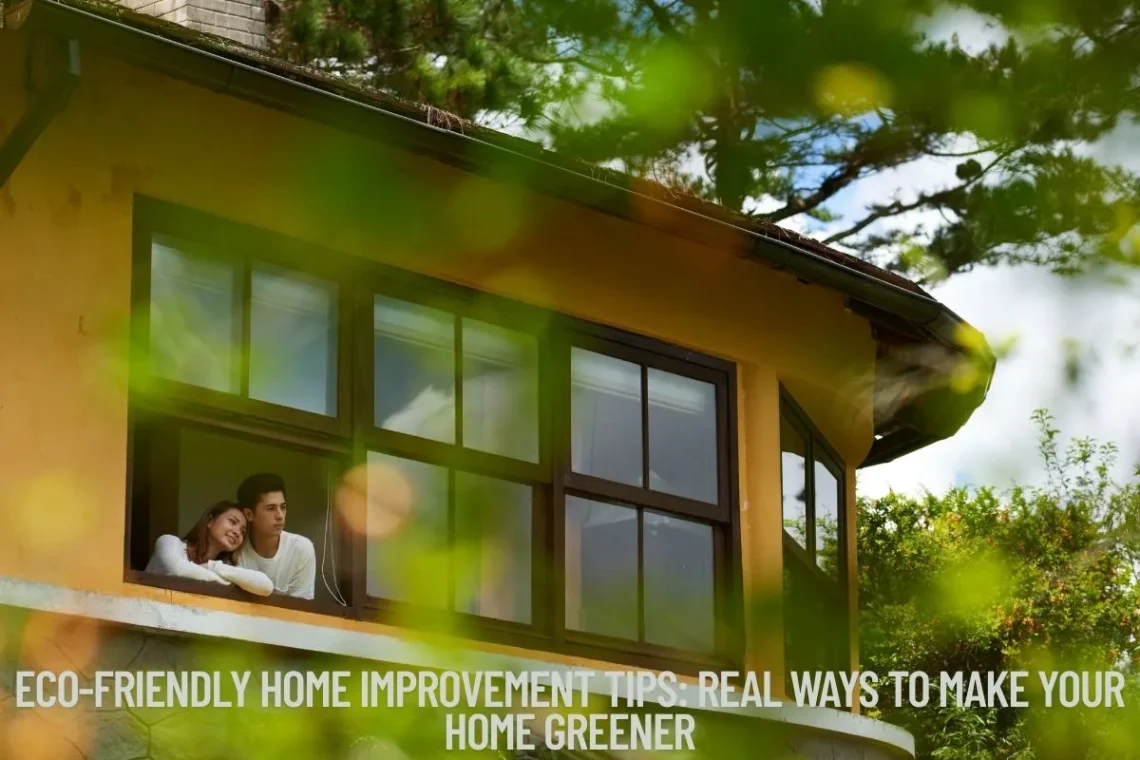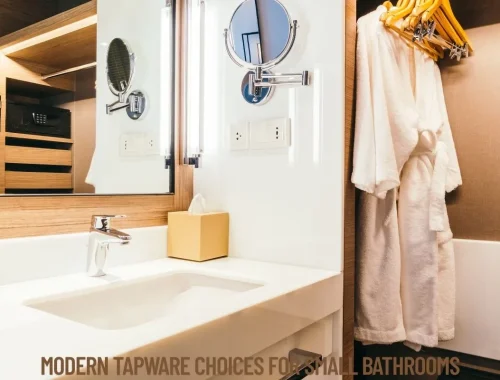
Eco-Friendly Home Improvement Tips: Real Ways to Make Your Home Greener
Improving your home doesn’t always mean spending a lot of money or buying the latest fancy gadgets. Sometimes, the smartest upgrades are the ones that help the planet while making your daily life easier and more comfortable. That’s what eco-friendly home improvement is all about—choosing sustainable options that reduce waste, save energy, and make your home healthier to live in.
I still remember when I decided to repaint my bedroom a few years ago. Instead of using regular paint, I tried a low-VOC eco-friendly paint. The difference was immediate—I didn’t feel dizzy from the strong smell, and the air felt fresher. That little decision made me realize that even small choices in home improvement can make a big difference for both health and the environment.
In this guide, we’ll explore practical, real-life tips you can start using today to make your home more eco-friendly. Whether you’re planning a big renovation or just looking for easy changes, you’ll find helpful ideas here.
Table of Contents
ToggleWhy Eco-Friendly Home Improvement Matters
When we hear the term eco-friendly, it sometimes feels like a trend or buzzword. But in reality, it’s about long-term benefits. Making sustainable upgrades can:
-
Save you money by lowering energy and water bills.
-
Improve your health by reducing harmful chemicals inside your home.
-
Help the planet by cutting down waste and carbon emissions.
-
Increase home value, as more buyers now look for green features.
Personally, after switching to LED lighting in my home, my electricity bill dropped by almost 20%. It’s not just good for the environment—it’s good for the wallet too.
How Do I Make My Home Eco-Friendly?
You don’t need a brand-new house or a huge budget. Anyone can start where they are. Here are the core steps:
1. Start With Energy Efficiency
-
Swap out old light bulbs for LED lights. They last longer and use less power. After we did this, our kitchen got brighter and the bills went down.
-
Seal cracks in doors and windows. Drafts let in cold or hot air, making your heater or AC work harder.
-
Use a programmable thermostat. Mine lets me set the heat to “sleep” while we’re away, then warms up right before we get home.
2. Save Water
-
Fix leaky faucets. I once ignored a drip in the main bathroom for weeks—until I saw the water bill!
-
Install low-flow toilets and showerheads. The showers feel the same, but we save gallons each day.
-
Collect rainwater if possible (check local rules). We use it in our garden, and our sunflowers thank us every summer.
3. Choose Safe, Natural Materials
-
Pick paints with low or no volatile organic compounds (VOCs). Our last repaint didn’t have that harsh smell, and it felt healthier.
-
Choose real wood, bamboo, or recycled materials for floors.
-
Support brands that share how their products are made.
4. Think About Heating and Cooling
-
Add insulation to your attic and walls.
-
Try ceiling fans—they use less energy than AC.
-
In winter, let sun stream through windows, then close curtains at night to keep in the warmth.
5. Reduce, Reuse, Recycle
-
Before buying something new, see if you can fix, repair, or reuse.
-
Donate old items—our used sofa made another family smile.
-
Sort recycling and compost food scraps if your area allows.
What Are 10 Ways to Go Green?
Here’s a list of 10 practical eco-friendly home improvement tips you can start today:
-
Switch to solar panels – Long-term investment but cuts electricity bills.
-
Use bamboo flooring – Durable, stylish, and more sustainable than hardwood.
-
Buy second-hand furniture – Reduces demand for new resources.
-
Choose energy-efficient appliances – Look for the Energy Star label.
-
Install water-saving fixtures – Low-flow showerheads and faucets reduce waste.
-
Compost food waste – Turns leftovers into natural fertilizer.
-
Plant native trees and shrubs – Reduces the need for watering.
-
Use natural cleaning products – Vinegar, baking soda, and lemon work wonders.
-
Seal windows and doors – Prevents drafts and saves energy.
-
Create a recycling station – Makes sorting waste easier for the whole family.
When I first tried composting, I thought it would smell bad. But with the right balance of food scraps and garden waste, it turned into rich soil that made my backyard tomatoes grow better than ever.
How Can I Be 100% Eco-Friendly?
Truthfully, being 100% eco-friendly is very difficult because almost everything we use has some impact on the environment. But you can get as close as possible by:
-
Using renewable energy (like solar or wind).
-
Living in an energy-efficient home with proper insulation.
-
Minimizing waste by recycling and composting.
-
Using sustainable materials in every renovation.
-
Choosing local products to reduce transportation emissions.
It’s not about perfection—it’s about progress. Even small changes like using cloth bags instead of plastic can add up over time.
What Are Five Eco-Friendly Habits?
If you’re not ready for big home projects yet, start with habits that can easily fit into your lifestyle:
-
Turn off lights when not in use.
-
Unplug devices that still consume power in standby mode.
-
Reuse items instead of throwing them away.
-
Save water by fixing leaks and turning off taps quickly.
-
Choose sustainable brands when buying home products.
For example, I made a habit of carrying a reusable water bottle everywhere. Over time, I noticed I wasn’t buying plastic bottles at all, which not only saved money but also reduced waste.
Eco-Friendly Upgrades That Pay Off
Let’s look at a few upgrades that might seem expensive at first but save money in the long run.
-
Solar Panels – They can cost several thousand dollars to install, but over 20 years, they often pay for themselves through energy savings.
-
Insulation & Double-Glazed Windows – Lower your heating and cooling costs significantly.
-
Smart Home Systems – Reduce wasted energy by automating lights and temperature control.
What Are Five Eco-Friendly Habits?
Building new habits is how real change lasts. Here are five easy ones to begin now:
1. Bring Your Own Bags and Bottles
-
Keep reusable bags in the car. I started leaving them in the front seat so I wouldn’t forget.
-
Use a refillable water bottle.
2. Choose Energy-Saving Settings
-
Wash clothes in cold water.
-
Use the quick cycle on your dishwasher.
-
Turn off lights when leaving a room. (I made this a “game” with my kids—whoever catches a light left on gets to make dessert!)
3. Eat Local and Seasonal Foods
-
Shopping at the farmers’ market has become a weekend ritual. The taste is amazing, and there’s less packaging.
4. Walk, Bike, or Share Rides
-
Leave the car when you can.
-
Plan errands to make fewer trips. Walking with my family has also led to fun talks and discoveries.
5. Recycle and Compost
-
Whether it’s at home or out and about, sort waste and compost whenever possible.
A Day in My Eco-Friendly Home: Personal Anecdotes
I’ll never forget the first time I opened an electricity bill after making eco-friendly upgrades. I expected the usual spike and was surprised—it was the lowest it had ever been. Our new windows let in more light but kept out drafts. The kids’ rooms felt cozy, not chilly. Our air purifier used hardly any power but kept hay fever at bay in spring.
Once, we planted native milkweed in backyard planters. That summer, we saw monarch butterflies for the first time! My son ran to grab his camera. Watching animals return to your space is a wonderful reward.
Unique Insights: Think Beyond the Obvious
-
Sometimes, eco-friendly choices are about what you don’t do. For example, resist “trendy” decor swaps—reuse and refresh what you have.
-
Try “graywater” systems (with local guidance) to reuse water from sinks for gardens.
-
Switch out turf for clover or native grass lawns—they use less water and stay green.
-
Small switches make a difference. I was skeptical about wool dryer balls but found laundry dried fast and towels were softer.
Where to Start: Choose One, Build Up
Don’t overwhelm yourself. Choose one or two tips from this list. Once you’ve made them a habit, try a new one. My eco-journey started small: a recycling bin in the kitchen and a reusable water bottle for school runs. Over months and years, those “just one things” added up to real change. The planet—and your future self—will thank you for every step you take.
Quick Checklist for an Eco-Friendly Home
-
LED bulbs installed
-
Drafts sealed, insulation checked
-
Water-saving showerheads and toilets
-
Eco-certified or homemade cleaning products
-
Recycle and compost bins in place
-
Native plants or trees in garden
-
Thermal curtains or window film
-
Buy local and seasonal food
-
Energy and water tracked monthly
Stick this on the fridge and celebrate every checked box!
Final Thoughts
Eco-friendly home improvement is not about doing everything at once or spending a fortune. It’s about making thoughtful choices that work for you and your family. From small habits like recycling to larger projects like installing solar panels, each step counts.
The best part? You don’t just help the planet—you also create a healthier, more cost-effective home. As I’ve learned from my own journey, every little choice adds up to a big impact.
So, start today. Maybe change one bulb, fix one leak, or swap one cleaning product. You’ll see the difference—and you’ll feel proud knowing you’re part of a greener future.
You May Also Like

🔥 Defy Cooker Oven Symbols Explained: What Each Icon Means and How to Use Them the Right Way
November 4, 2025
Montecito Country Club Easement Dispute: What Really Happened?
May 28, 2025

